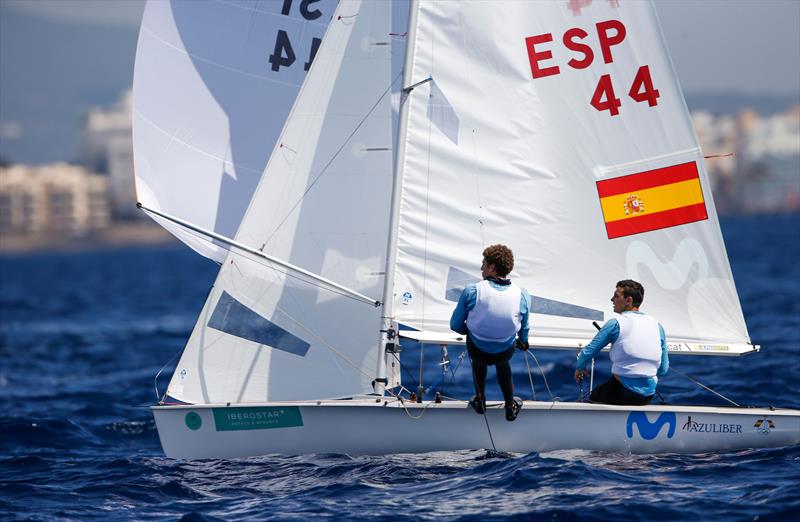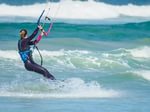
by John Curnow, Editor, Sail-World AUS 2 Feb 13:00 PST
 Xammar & Rodriguez (ESP) on day 2 of Trofeo Princesa Sofia Iberostar © Jesus Renedo / Sailing Energy
Xammar & Rodriguez (ESP) on day 2 of Trofeo Princesa Sofia Iberostar © Jesus Renedo / Sailing EnergyYou know, sailing is more than ever a wider, and divergent set of groupings. It is not simply Off The Beach or Keelboat, inshore or off, low ride v high ride, planing over grading the ocean, symmetrical or A-Bag. Then there’s your choice of medium in water, land or ice. Long booms and Bermudan rigs and no roach on white sails can look positively archaic against black/clear square-tops, and then they are all still attached to a stick, not free floating and controlled by lines.
The 470 is like 57 years old now, and has been in Olympic service since Montreal (1976 in case you are fortunate enough to be that young). Yet the progression, and the closeness of the competition at the elite level does mean that teams are very much pushing hard, as they look to secure gains. This is not something new, for it has been ten years in the making, since the class allowed itself to become more dynamic.
When a team secures an advantage, pretty much everyone follows suit. Invariably, a lot of these gains are made on the back of doing a huge amount of the circuit, and that is a major investment in time. The recent Hempel World Cup Series in Miami certainly showed just how far the Spanish have come in the realm of pumping and rocking, and remember that only applies in the small window of like 8-11 knots of breeze and flat water.
“In certain scenarios, the 470 is like a windsurfer uphill, a Finn downhill, and you are doing skiff angles”, said Mat Belcher, who along with Will Ryan, are the reigning World Champions in the class. “It takes a lot to co-ordinate two people, and yet it all is so very Laser like.”
What these comments show is a deep understanding of all the applicable techniques, for the 470 is a technical boat – first and foremost. The boat has a got a bit of everything, and certainly now has an even more visible physical aspect. Just like the Finn they (can) pump off the breeze, but unlike other dinghies they can also do it uphill, even if this is far from the prettiest action. One thing for sure, it is certainly a work out the likes of carrying kettles and throwing tyres would love to be on a par with.
So if the pumping and rocking looks weird, then you also need to factor in that it is also somewhat complicated. You have two people and (up to) three sails to co-ordinate, and very importantly, the communications about what you’re up to between the crew. Then there are all the technical aspects of tuning, understanding the settings, and helming, along with ascertaining in which mode you are operating in, either up or downhill. In other words, a lot to think about, so I am sure this is why Belcher says, “…a really enjoyable part of it all.”
Invariably, pumping and rocking does take some of the tactical elements away, as the speed differentials from the apparent come into play, yet make no mistake, the 470 sailors are really fit do be able to do this. In a lot of ways, the 470 continues to show that sailing is changing, which is no mean feat for an elderly craft. The class has developed different things over time, and the sailors have picked the best of everything.
There is still the big tuning side to the craft, with leech profiles and sail shapes still critical, for at this level, small changes make big changes, and all these ‘later’ developments have meant there is a huge range of options available to today’s 470 crew, so there is a lot of thinking that has gone in to make a crew that is capable across the board. Again, for the thinking person’s sailor, I am sure the widening of the game and the calculations of all the new angles makes the maths very enjoyable.
So if the last ten years has seen a shift to a more physical boat, then those doing the best have come from a good understanding of the boat and knowledge of how far to push. It is aggression versus static feel, you know the old seat of the pants type stuff, and the control it all takes to get the most out of it all without losing one’s focus on the entire picture. The current crop certainly have changed the way the 470 is sailed, with the Spaniards arguably leading the charge in many areas, and certainly with the ones under review here.
Balance of trim and steering will always be crucial, but in the 470 we may be seeing what it is like to cross over when conditions suit. In other words, they are expanding our minds, by not pigeon holing themselves, or us all. Many could understand kiteboarding, and especially kitefoiling being classed as sailing, yet forgot to look at the fact that we are all involved in a wind sport. Our sport is evolving, and it is certainly unique. Long may that all reign. To see what this little ditty has been all about, simply –
Right oh – there is plenty of information on the site for you to review when you can. Please avail yourself of it. Reckon the forestay going on an AC75 would have the heart rate bouncing off the rev limiter. Very happy they kept it in one piece, because I don’t think a new one of those would be ready in time for Sardinia. Before all of that, SailGP kicks off for Season Two in Sydney once more, and Ribco have gone one better this year moving up from being just the chase boat for Team AUS to that of the whole event. Well done Oliver and Pilar.
Now if your class or association is generating material, we can help you spread your word just by . Got this newsletter from a friend? Would you like your own copy next week? Just follow the instructions on our Whilst there, you can also register for other editions, like Powerboat-World.
Finally, keep a weather eye on Sail-World. We are here to bring you the whole story from all over the world…
John Curnow
Editor, Sail-World AUS





Recent Comments